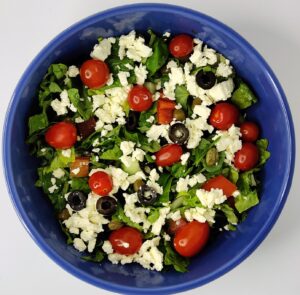
Cheese is an age-old staple, beloved for its richness, creaminess, flavor, and satiating qualities. It was discovered in ancient civilizations during the rise of agriculture and domestication of sheep and goats for their milk. By accident, when the milk was left sitting out in the sun for hours, it turned sour and the protein components curdled into solids. When the liquid portion, or whey, was drained and removed leaving only the solid curds, farmers realized these curds had a pleasing taste.
Since then, countries around the world have experimented with cheese-making, varying the types of milk, how long the cheese is allowed to age and ripen, and using different additives like salt or acid to produce unique textures and flavors. India is known for its mild-tasting soft paneer, Greece discovered salty crumbly feta made from sheep or goat’s milk, and Sardinia developed the hard, pungent grating cheese called Pecorino Romano.
Cheese is a nutrient-dense dairy food, providing protein, fats, and minerals. Some hard block cheeses that contain little moisture like Parmigiano-Reggiano and aged cheddar are easily stored and travel well because they do not require refrigeration. Cheese may be better tolerated than milk in some people because it is lower in lactose, a type of sugar that is not easily digested if people lack the enzyme to break it down.
Source Of
- Calcium
- Protein
- Phosphorus
- Vitamin B12
- Vitamin A
The nutrients in cheese vary. One ounce of hard cheese, or a wedge about the size of your thumb, contains about 120 calories, 8 grams (g) of protein, 6 g saturated fat, and 180 milligrams (mg) of calcium. A half-cup of soft cheese like 4% full-fat cottage cheese has about 120 calories, 14 g protein, 3 g saturated fat, and 80 mg of calcium. Most cheeses are high in sodium with 300-450 mg per serving because salt is a key ingredient to hold moisture and prevent overgrowth of bacteria. However, some cheeses like goat, whole-milk mozzarella, and Swiss are low in sodium with only 50-100 mg per serving.
Cheese and Health
Full-fat dairy foods contain a high amount of saturated fat and some cholesterol. Milk fat is about 70% saturated fat, 25% monounsaturated, and 5% polyunsaturated. Because a high intake of saturated fat can increase LDL cholesterol levels, and because cheese is often high in sodium, it is generally recommended to eat cheese in limited amounts as its components may exert a negative health effect.
However, there is ongoing debate about the impact of cheese on health. Though the U.S. Dietary Guidelines recommend choosing low-fat dairy (milk, yogurt, and cheese) to prevent cardiovascular disease (CVD), some reports suggest that full-fat dairy may lower risk of CVD and type 2 diabetes. [1] It is suggested in these studies that perhaps specific nutrients in cheese may be protective for the heart, like calcium and conjugated linoleic acid, and that the types of saturated fatty acids in cheese have a different effect on the heart than other types such as that in red meat. During the processing of some cheeses, bacteria are added during the fermentation stage, which may alter its effects on blood cholesterol. However, this is a fairly new theory with early evidence arising mainly from certain cheeses manufactured with probiotics.
An important point to consider is that many published studies showing a health benefit of cheese are funded by industries such as dairy associations or large commercial corporations that sell dairy foods. The studies discussed below did not have industry conflicts of interest, to the best of our knowledge.
It appears that cheese might have some benefit with strokes and weight changes, specifically when replacing red meat in the diet. That said, the dietary patterns associated with cheese intake can make a difference. In the U.S. for example, cheese is often added to a pizza or burger containing refined grains, meats high in saturated fats, and sodium. Such a dietary pattern is likely to have an adverse health effect regardless of the amount of cheese consumed.
Bottom line: Although cheese is high in saturated fat and sodium, it is also rich in calcium and protein, and some fermented types contain probiotics. One can enjoy a modest amount of cheese as part of a healthful diet, but how it is eaten is key. Eating cheese with foods like refined grains (white pasta, bread, crackers, etc.) and processed meats may negate its health benefits. On the other hand, cheese may provide health benefits if consumed as a replacement for red and processed meats or eaten as a snack instead of potato chips (although nuts would still be a healthier snack option!).
For Your Health and the Planet’s Health
The production of dairy foods places considerable demand on land, water, and other natural resources, and dairy-producing ruminant animals like cattle, sheep, and goats generate methane—a powerful greenhouse gas. In identifying a dietary pattern both healthy for people and sustainable for the planet, the “planetary health diet” sets the target for dairy foods at 250 grams per day, with a range of 0 to 500 grams per day. 250 grams is about one (8-ounce) cup of milk, or equivalent amounts of cheese (because milk is about 90% water, this amounts to about 1 oz of hard cheese).
Production

There are three main components for making cheese: the milk, a coagulant, and bacterial cultures. Cheese is made mostly of milk, whether from cows, sheep, goats, buffalo or a blend of these milks. A coagulant is a substance added to milk to help solids form out of the liquid portion. This is typically an acid like vinegar, or rennet, a natural enzyme found in the stomach lining of cows. Starter bacteria are added to help with coagulation, impart flavor and texture, and prevent the growth of harmful organisms. They feed on lactose sugar in the milk. You can see the work of bacteria in the eye holes in Swiss cheese or in the pungency of sharp cheddar. Sometimes molds are added that produce an unusual appearance like the greyish-blue veins in blue cheese and the hard rinds of Brie and Camembert.
Pasteurized or raw milk may be used. Both types of milk are heated to a temperature to allow the starter bacteria to grow and ferment the milk. If raw milk is used, the cheese must further be aged for at least two months to reduce the exposure to harmful pathogens present in the milk. A coagulant is then added with heat, after which the whey is drained out. At this point, salt or herbs may be added and the cheese may be pressed into blocks. Depending on the type of cheese, it will be stored from months to years until the desired ripening and aging is achieved.
Why do some cheeses stink?
Purchase
- Most cheese is sold refrigerated in the dairy case. Some grocery stores display gourmet cheeses in a separate case. There are also boutique cheese shops that may carry more unique varieties of imported or artisan cheeses. A cheesemaker makes cheeses; a fromager or cheesemonger sells cheeses.
- Purchasing cheese from a specialty cheese shop is often pricier than cheese found in the dairy case, so it is worth your time to find a seller that can educate you on different types of cheeses available. This will ensure that you receive your money’s worth of the variety that best fits your taste preferences. Consider:
- Type of milk. In general, cow’s milk cheese tends to be rich and buttery, goat’s milk cheeses carry a sharp tang, and sheep’s milk cheeses have a mild nutty flavor.
- Texture. Hard, granular, crumbly (pecorino, Parmigiano-Reggiano, Grana Padano, manchego, aged Gouda, Asiago, aged cheddar); semi-hard (mild cheddar, Colby, Gouda); semi-soft (haloumi, chevre or goat, baby Swiss); or soft (Brie, Camembert, cottage, feta, farmer, Gorgonzola, fresh mozzarella, ricotta).
- Location. Cheese flavor is affected by climate, temperature, diet of the animal, and when the animals were milked, so even the same type of cheese tastes different when produced in different areas of the world.
Storage
- Softer cheeses like cream, cottage, goat, and shredded types have a high moisture content and should be refrigerated to prevent bacterial growth. The lower moisture in harder cheeses prevents bacteria from developing so they do not need to be refrigerated, but cooler temperatures can preserve their flavor and texture longer. In general, opened soft cheeses last in the refrigerator at 40-45 F for about 2 weeks. After that, there is risk of mold growth. Check the label’s use-by date for storage information about specific cheeses. Unopened refrigerated hard cheeses last about 2-4 months; if opened they last about 1 month. Sealed and opened hard cheeses last even longer in the freezer, about 7 months, if they are tightly sealed from oxygen.
- Although cheese may be sold in plastic wrapping or cellophane, tightly wrapped plastic can cause too much moisture to collect and increases the risk of rotting. Rewrapping the cheese loosely in wax paper or aluminum foil can prevent the cheese from drying out but allow it to “breathe.” If the cheese is refrigerated and has a strong odor, it may be placed in a sealed plastic container. It can also be placed in the produce drawer in the refrigerator to further regulate temperature, minimize exposure to oxygen, and prevent odor transfer to other foods.
Serve
- Typically the flavor of cheese is best at room temperature, whether a soft or hard cheese.
- The rind of hard cheeses naturally forms during the ripening process. In most cases it is edible but may be removed if it is too tough or waxy. Softer rinds such as that with Brie are often enjoyed along with the creamy interior.
- Although cheese is commonly served with crackers as a snack, try taking a few bites first of just the cheese to appreciate its unique flavor. Crackers can dilute the full flavor of the cheese.
- If consuming cheese with wine, know that certain pairings can enhance cheese flavor. Fresh softer cheeses like Brie, ricotta, goat, and halloumi pair well with white wines and red wines low in tannins like Chablis, Moscato, and Pinot Grigio. Harder cheeses like aged cheddar, pecorino, and manchego go well with high-tannin wines like Burgundy, Bordeaux, and Zinfandel. You might try pairing very salty cheese like blue with the contrasting sweet flavor of a Port or sherry.
- Similarly, salty cheeses are also complimented by sweet dried and fresh fruits: apples, cherries, dates, figs, and apricots.
 If you are concerned about the cholesterol, sodium, and high saturated fat content of full-fat cheeses, consider using them as a condiment. Top off a soup, salad, vegetables, or grain dish with a freshly shredded tangy cheese. Crumble a small handful of feta or goat cheese onto raw or cooked vegetables. Add a dusting of shredded mozzarella to a homemade pizza.
If you are concerned about the cholesterol, sodium, and high saturated fat content of full-fat cheeses, consider using them as a condiment. Top off a soup, salad, vegetables, or grain dish with a freshly shredded tangy cheese. Crumble a small handful of feta or goat cheese onto raw or cooked vegetables. Add a dusting of shredded mozzarella to a homemade pizza.- If you aren’t a fan of cheese, or looking to reduce your consumption, nuts and seeds can be a satiating swap in a variety of ways: almond or sunflower seed butter spread on a sandwich; pecans sprinkled on a salad; or freshly toasted walnuts finely grated over the top of a dish. Increasingly, cashews, macadamia, and other nuts are also being used in a variety of dairy-free cheeses, where nut milks are cultured with bacteria and aged to impart that classic tangy flavor.
Did You Know?
- Some types of cheese are low in lactose and may be tolerated in people who have lactose intolerance. Firmer cheeses such as cheddar, mozzarella, and Swiss cheese tend to be lower in lactose, but creamy cheeses like cottage, ricotta, and cream cheese are higher in lactose.
- Europe produces and eats the most cheese worldwide. The biggest consumers, the French, eat about 57 pounds of cheese annually per person! Americans eat less at about 34 pounds a year, however the most notable difference between the two countries may be the typical role of cheese on the plate. In France, cheese is often served as a post-meal palate cleanser before dessert, or as the dessert itself. It is purposefully and artfully cut into various shapes and arranged with other types of cheeses to contrast flavors and textures of soft, medium, and hard. It is often eaten slowly and savored, and sips of wine may be taken between each bite. In the U.S., cheese is more often added to numerous mixed dishes—melted into pasta, topping a burger, coating a pizza, or stacked on crackers. Of course, these approaches to cheese consumption are not mutually exclusive. Brie can be found in Boston, just as easy as cheesy pizza in Paris.
Last reviewed October 2020


